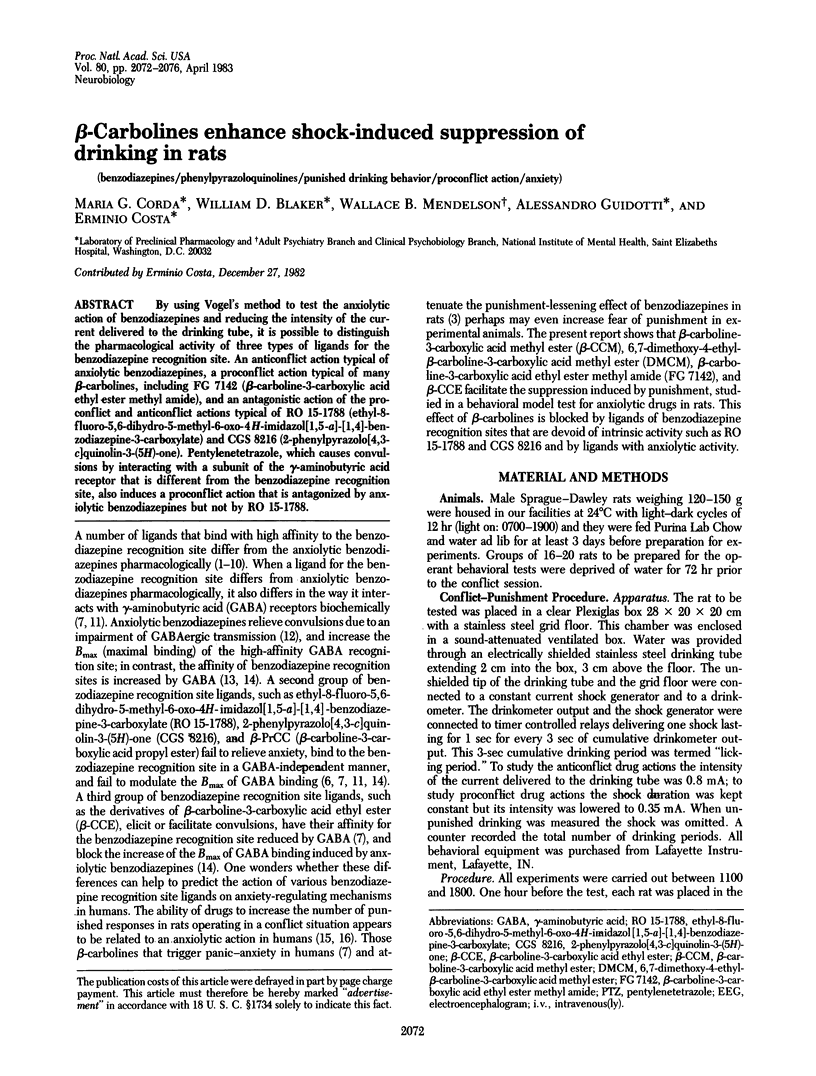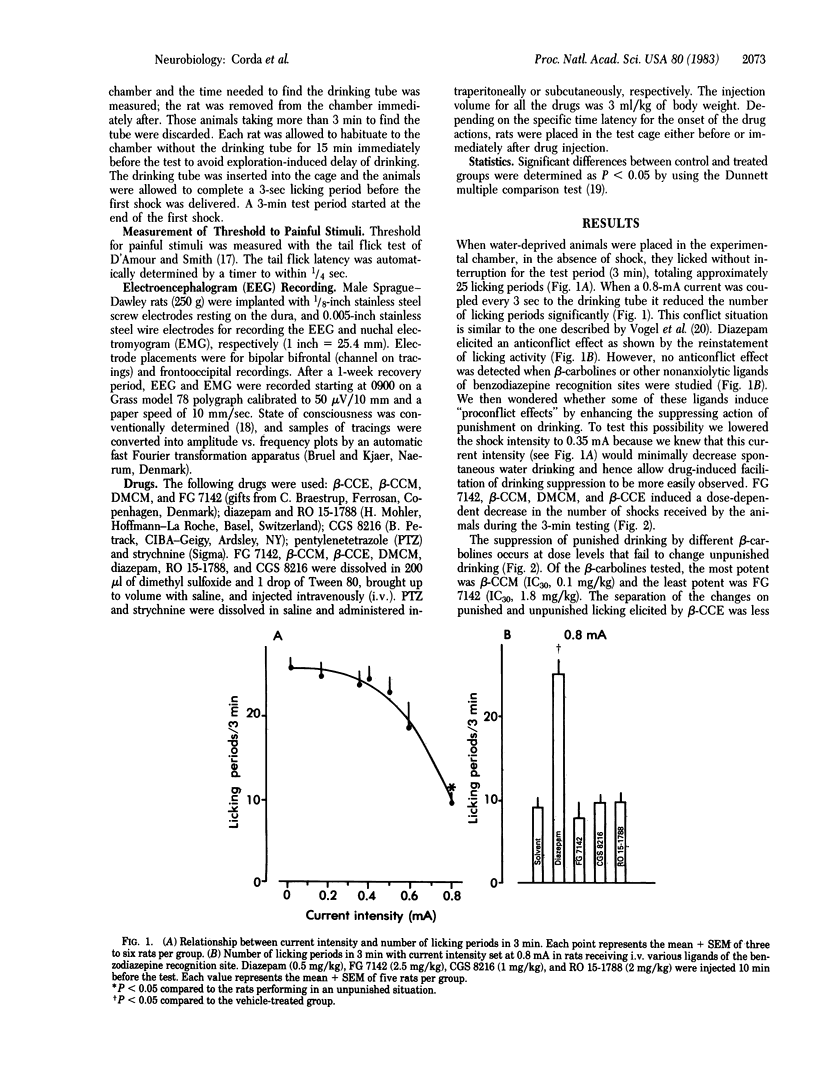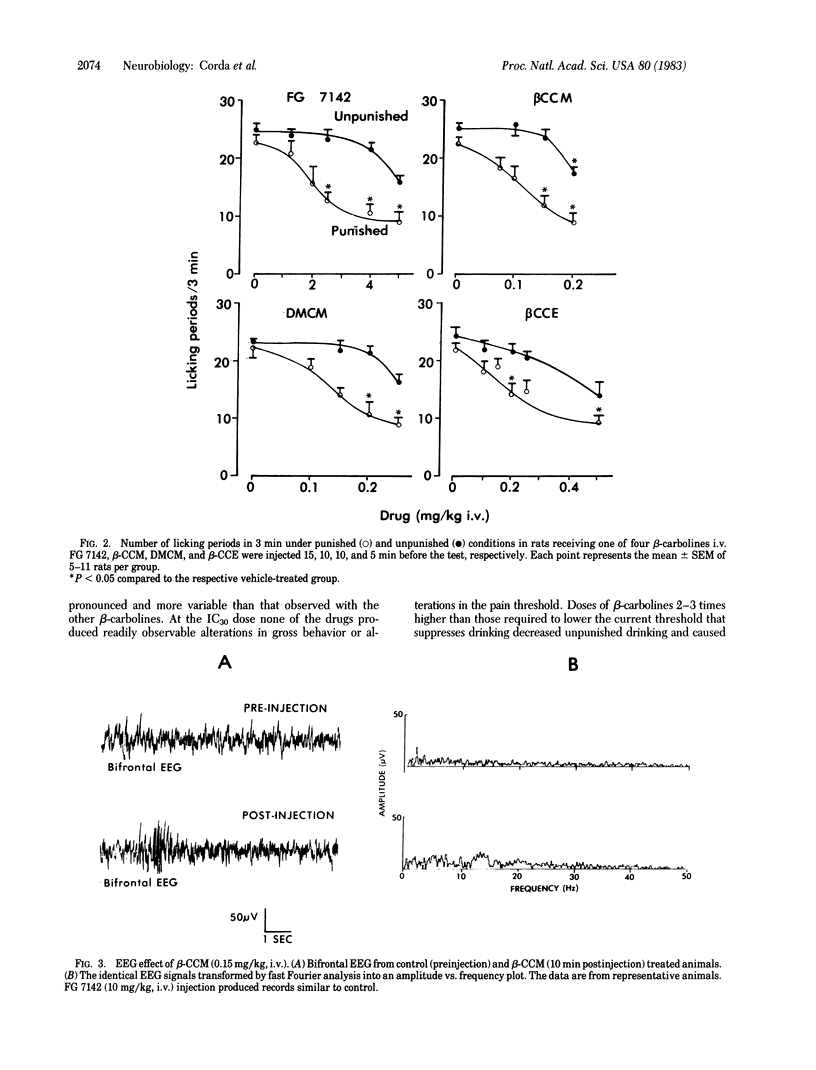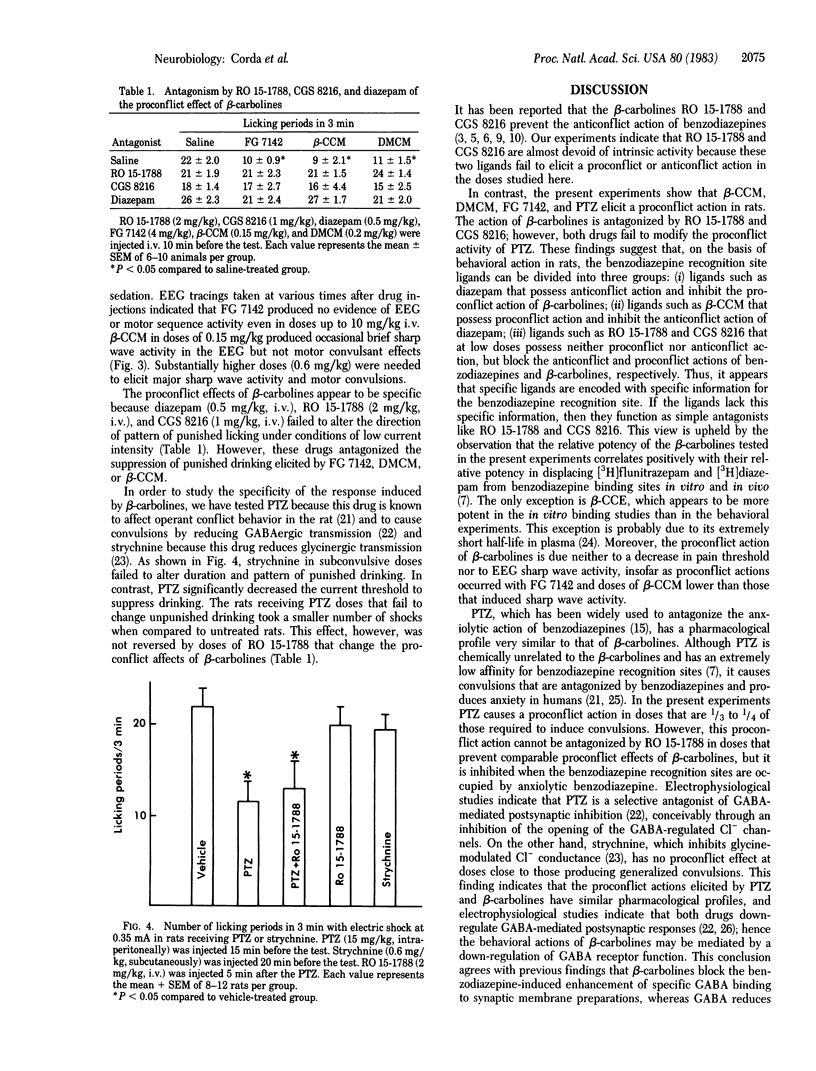Abstract
By using Vogel's method to test the anxiolytic action of benzodiazepines and reducing the intensity of the current delivered to the drinking tube, it is possible to distinguish the pharmacological activity of three types of ligands for the benzodiazepine recognition site. An anticonflict action typical of anxiolytic benzodiazepines, a proconflict action typical of many beta-carbolines, including FG 7142 (beta-carboline-3-carboxylic acid ethyl ester methyl amide), and an antagonistic action of the proconflict and anticonflict actions typical of RO 15-1788 (ethyl-8-fluoro-5, 6-dihydro-5-methyl-6-oxo-4H-imidazol[1,5-alpha]-[1, 4]-benzodiazepine-3-carboxylate) and CGS 8216 (2-phenylpyrazolo[4,3-c]quinolin-3-(5H)-one). Pentylenetetrazole, which causes convulsions by interacting with a subunit of the gamma-aminobutyric acid receptor that is different from the benzodiazepine recognition site, also induces a proconflict action that is antagonized by anxiolytic benzodiazepines but not by RO 15-1788.
Full text
PDF




Selected References
These references are in PubMed. This may not be the complete list of references from this article.
- Billingsley M. L., Kubena R. K. The effects of naloxone and picrotoxin on the sedative and anticonflict effects of benzodiazepines. Life Sci. 1978 Mar;22(10):897–906. doi: 10.1016/0024-3205(78)90614-8. [DOI] [PubMed] [Google Scholar]
- Braestrup C., Schmiechen R., Neef G., Nielsen M., Petersen E. N. Interaction of convulsive ligands with benzodiazepine receptors. Science. 1982 Jun 11;216(4551):1241–1243. doi: 10.1126/science.6281892. [DOI] [PubMed] [Google Scholar]
- Cananzi A. R., Costa E., Guidotti A. Potentiation by intraventricular muscimol of the anticonflict effect of benzodiazepines. Brain Res. 1980 Sep 8;196(2):447–453. doi: 10.1016/0006-8993(80)90408-4. [DOI] [PubMed] [Google Scholar]
- Cepeda C., Tanaka T., Besselièvre R., Potier P., Naquet R., Rossier J. Proconvulsant effects in baboons of beta-carboline, a putative endogenous ligand for benzodiazepine receptors. Neurosci Lett. 1981 Jun 12;24(1):53–57. doi: 10.1016/0304-3940(81)90358-x. [DOI] [PubMed] [Google Scholar]
- Cowen P. J., Green A. R., Nutt D. J. Ethyl beta-carboline carboxylate lowers seizure threshold and antagonizes flurazepam-induced sedation in rats. Nature. 1981 Mar 5;290(5801):54–55. doi: 10.1038/290054a0. [DOI] [PubMed] [Google Scholar]
- Curtis D. R., Duggan A. W., Johnston G. A. The specificity of strychnine as a glycine antagonist in the mammalian spinal cord. Exp Brain Res. 1971 Jun 29;12(5):547–565. doi: 10.1007/BF00234248. [DOI] [PubMed] [Google Scholar]
- Fehske K. J., Muller W. E. beta-Carboline inhibition of benzodiazepine receptor binding in vivo. Brain Res. 1982 Apr 22;238(1):286–291. doi: 10.1016/0006-8993(82)90799-5. [DOI] [PubMed] [Google Scholar]
- Guidotti A., Konkel D. R., Ebstein B., Corda M. G., Wise B. C., Krutzsch H., Meek J. L., Costa E. Isolation, characterization, and purification to homogeneity of a rat brain protein (GABA-modulin). Proc Natl Acad Sci U S A. 1982 Oct;79(19):6084–6088. doi: 10.1073/pnas.79.19.6084. [DOI] [PMC free article] [PubMed] [Google Scholar]
- Hunkeler W., Möhler H., Pieri L., Polc P., Bonetti E. P., Cumin R., Schaffner R., Haefely W. Selective antagonists of benzodiazepines. Nature. 1981 Apr 9;290(5806):514–516. doi: 10.1038/290514a0. [DOI] [PubMed] [Google Scholar]
- Macdonald R. L., Barker J. L. Specific antagonism of GABA-mediated postsynaptic inhibition in cultured mammalian spinal cord neurons: a common mode of convulsant action. Neurology. 1978 Apr;28(4):325–330. doi: 10.1212/wnl.28.4.325. [DOI] [PubMed] [Google Scholar]
- Mendelson W. B., Guthrie R. D., Frederick G., Wyatt R. J. The flower pot technique of rapid eye movement (REM) sleep deprivation. Pharmacol Biochem Behav. 1974 Jul-Aug;2(4):553–556. doi: 10.1016/0091-3057(74)90018-5. [DOI] [PubMed] [Google Scholar]
- Möhler H., Richards J. G. Agonist and antagonist benzodiazepine receptor interaction in vitro. Nature. 1981 Dec 24;294(5843):763–765. doi: 10.1038/294763a0. [DOI] [PubMed] [Google Scholar]
- Nutt D. J., Cowen P. J., Little H. J. Unusual interactions of benzodiazepine receptor antagonists. Nature. 1982 Feb 4;295(5848):436–438. doi: 10.1038/295436a0. [DOI] [PubMed] [Google Scholar]
- Oakley N. R., Jones B. J. The proconvulsant and diazepam-reversing effects of ethyl-beta-carboline-3-carboxylate. Eur J Pharmacol. 1980 Dec 5;68(3):381–382. doi: 10.1016/0014-2999(80)90538-5. [DOI] [PubMed] [Google Scholar]
- Petersen E. N., Paschelke G., Kehr W., Nielsen M., Braestrup C. Does the reversal of the anticonflict effect of phenobarbital by beta-CCE and FG 7142 indicate benzodiazepine receptor-mediated anxiogenic properties? Eur J Pharmacol. 1982 Aug 27;82(3-4):217–221. doi: 10.1016/0014-2999(82)90517-9. [DOI] [PubMed] [Google Scholar]
- Polc P., Ropert N., Wright D. M. Ethyl beta-carboline-3-carboxylate antagonizes the action of GABA and benzodiazepines in the hippocampus. Brain Res. 1981 Jul 27;217(1):216–220. doi: 10.1016/0006-8993(81)90204-3. [DOI] [PubMed] [Google Scholar]
- Tallman J. F., Thomas J. W., Gallager D. W. GABAergic modulation of benzodiazepine binding site sensitivity. Nature. 1978 Jul 27;274(5669):383–385. doi: 10.1038/274383a0. [DOI] [PubMed] [Google Scholar]
- Tenen S. S., Hirsch J. D. beta-Carboline-3-carboxylic acid ethyl ester antagonizes diazepam activity. Nature. 1980 Dec 11;288(5791):609–610. doi: 10.1038/288609a0. [DOI] [PubMed] [Google Scholar]
- Vogel J. R., Beer B., Clody D. E. A simple and reliable conflict procedure for testing anti-anxiety agents. Psychopharmacologia. 1971;21(1):1–7. doi: 10.1007/BF00403989. [DOI] [PubMed] [Google Scholar]
- Yokoyama N., Ritter B., Neubert A. D. 2-Arylpyrazolo[4,3-c]quinolin-3-ones: novel agonist, partial agonist, and antagonist of benzodiazepines. J Med Chem. 1982 Apr;25(4):337–339. doi: 10.1021/jm00346a002. [DOI] [PubMed] [Google Scholar]
- Zakusov V. V., Ostrovskaya R. U., Kozhechkin S. N., Markovich V. V., Molodavkin G. M., Voronina T. A. Further evidence for GABA-ergic mechanisms in the action of benzodiazepines. Arch Int Pharmacodyn Ther. 1977 Oct;229(2):313–326. [PubMed] [Google Scholar]


